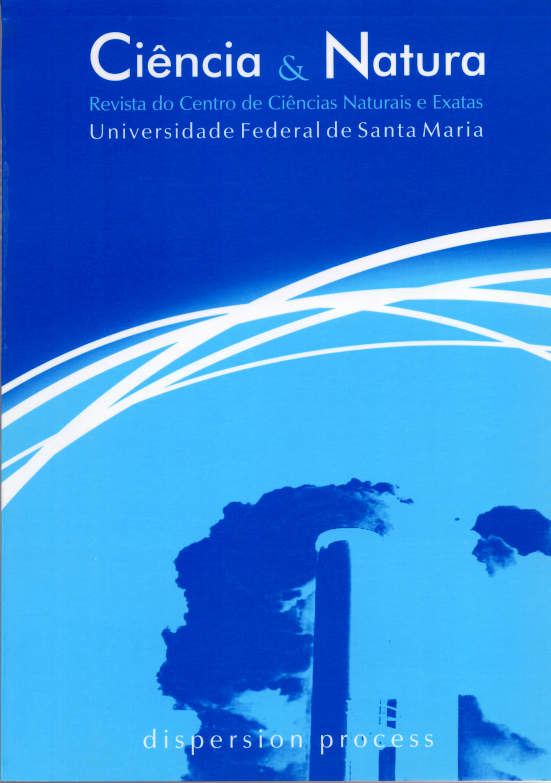A influência das condições de estabilidade atmosférica nas flutuações de concentração nas superfícies de um obstáculo isolado
DOI:
https://doi.org/10.5902/2179460X63620Palavras-chave:
flutuação de concentração, estratificação térmica, escoamento turbulento, intermitência.Resumo
A dispersão da pluma de poluentes próxima a obstáculos é um tema de interesse para arquitetos, agências reguladoras e meteorologistas da poluição do ar. Neste trabalho investiga-se as influências das condições de estabilidade atmosférica e do tempo de média na razão entre as concentrações máximas e as concentrações médias e na intensidade da flutuações de concentração, nas superfícies de um obstáculo isolado. Os dados para realização deste trabalho foram obtidos dos experimentos de campo realizados por Santos (2000). Foram utilizados detectores de foto-ionização com alta freqüência (50Hz) para se obter as flutuações turbulentas de concentração. Na região do fluxo incidente, as séries temporais de concentração apresentaram episódios de concentração nula seguidos de altos valores “instantâneos” de concentração, sugerindo que nesta região existem vórtices de escalas da turbulência de tamanhos maiores ou comparáveis ao tamanho da pluma. A estratificação térmica influenciou os valores da intensidade das flutuações turbulentas de concentração na região de esteiraDownloads
Referências
BROWN, S.T., Concentration prediction for meandering plumes based on probability theory, Atmospheric Environment 21, 1987, pp 1312-1330. DOI: https://doi.org/10.1016/0004-6981(67)90079-0
GRIFFITHS, R.F. e MEGSON, L.C., The effect on uncertainties in human toxic response on hazard range estimation for ammonia and chlorine, Atmospheric Environment, 1984, vol. 18, pp. 1195-10206. DOI: https://doi.org/10.1016/0004-6981(84)90151-3
HIGSON, H.L.; GRIFFITHS, R.F.; JONES, C.D.; BILTOFT, C., E., Effect of atmospheric stability on concentration fluctuation and wake retention times for dispersion in the vicinity of an isolated building, Environmetrics, 1996, vol. 6, pp. 571-581. DOI: https://doi.org/10.1002/env.3170060604
HINDS, W.T., Peak-to-mean concentration ratios from ground-level sources in building wakes, Atmospheric Environment, 3, 1969, pp.145-156. DOI: https://doi.org/10.1016/0004-6981(69)90005-5
HOSKER, R.P., Methods for estimating wake flow and effluent dispersion near simple block-like building, NOOA Technical Memorandum ERL ARL-108, 1981. DOI: https://doi.org/10.2172/5359876
JONES, C.D. e GRIFFITHS, R.F, Full-Scale experiments on dispersion around an isolated building using an Ionised Air Tracer Techinique with a very short averagint time, Atmospheric Environment, 18, 1984, pp. 903-916. DOI: https://doi.org/10.1016/0004-6981(84)90066-0
LI, W. e MERONEY, R.N., Gas dispersion near a cubical model building. Part II.concentration fluctuation measurements, Journal of Wind Engineering and Industrial Aerodynamics, 1983, 12, pp. 35-17. DOI: https://doi.org/10.1016/0167-6105(83)90079-X
MAVROIDIS, I. e GRIFFITHS, R.F, Field and wind tunnel examination of the dipersion of atmospheric pollutants near a model building, Air quality and pollution control, 1999, pp.476-484.
OIKAWA, S. e MENG, Y., A field study of diffusion around a model cube in a suburban área, Boundary Layer Meteorology, 1997, vol. 84, pp.339-410. DOI: https://doi.org/10.1023/A:1000496929585
SAATHOFF, P.J., STATHOPOULOS T. e DOBRESCU, M., Effects of Model Scale in Estimating Pollutant Dispersion near Buildings, Journal of Wind Eng. Ind. Aero., 1995, vol.54/55, pp. 549-559. DOI: https://doi.org/10.1016/0167-6105(94)00071-K
SANTOS, J.M., Flow and dispersion around isolated building, Tese de Ph.D. , Departamento de Engenharia Química da Universidade de Manchester, 2000.
SANTOS, J.M., GRIFFITHS, R.F. , JONES, C.D. e HALL, D.J., Wind flow and concentration fluctuation data around and obstacle: a field experiment work, NATO/CCMS International Technical Meeting on Air Pollution, 1998, vol. 1, pp. 763-764. DOI: https://doi.org/10.1007/978-1-4615-4153-0_95
SNYDER, W.H., Some Observations of the Influence of Stratification on Diffusion in Buildings Wakes, In Stably Stratified Flows – Flow
and Dispersion over Topographt (Edited by I.P. Castro and N.J. Rockliff), Clarendon Press, 1994, pp.301-324.
STROM, G.H., Transport and Diffusion of Stack Effluent, Air Pollution, Editor Stern C., Academic Press, 1976, vol. 1, pp. 401-501a.
Downloads
Publicado
Como Citar
Edição
Seção
Licença
Para acessar a DECLARAÇÃO DE ORIGINALIDADE E EXCLUSIVIDADE E CESSÃO DE DIREITOS AUTORAIS clique aqui.
Diretrizes Éticas para Publicação de Revistas
A revista Ciência e Natura está empenhada em garantir a ética na publicação e na qualidade dos artigos.
A conformidade com padrões de comportamento ético é, portanto, esperada de todas as partes envolvidas: Autores, Editores e Revisores.
Em particular,
Autores: Os Autores devem apresentar uma discussão objetiva sobre a importância do trabalho de pesquisa, bem como detalhes e referências suficientes para permitir que outros reproduzam as experiências. Declarações fraudulentas ou intencionalmente incorretas constituem comportamento antiético e são inaceitáveis. Artigos de Revisão também devem ser objetivos, abrangentes e relatos precisos do estado da arte. Os Autores devem assegurar que seu trabalho é uma obra totalmente original, e se o trabalho e / ou palavras de outros têm sido utilizadas, isso tem sido devidamente reconhecido. O plágio em todas as suas formas constitui um comportamento publicitário não ético e é inaceitável. Submeter o mesmo manuscrito a mais de um jornal simultaneamente constitui um comportamento publicitário não ético e é inaceitável. Os Autores não devem submeter artigos que descrevam essencialmente a mesma pesquisa a mais de uma revista. O Autor correspondente deve garantir que haja um consenso total de todos os Co-autores na aprovação da versão final do artigo e sua submissão para publicação.
Editores: Os Editores devem avaliar manuscritos exclusivamente com base no seu mérito acadêmico. Um Editor não deve usar informações não publicadas na própria pesquisa do Editor sem o consentimento expresso por escrito do Autor. Os Editores devem tomar medidas de resposta razoável quando tiverem sido apresentadas queixas éticas relativas a um manuscrito submetido ou publicado.
Revisores: Todos os manuscritos recebidos para revisão devem ser tratados como documentos confidenciais. As informações ou ideias privilegiadas obtidas através da análise por pares devem ser mantidas confidenciais e não utilizadas para vantagens pessoais. As revisões devem ser conduzidas objetivamente e as observações devem ser formuladas claramente com argumentos de apoio, de modo que os Autores possam usá-los para melhorar o artigo. Qualquer Revisor selecionado que se sinta desqualificado para rever a pesquisa relatada em um manuscrito ou sabe que sua rápida revisão será impossível deve notificar o Editor e desculpar-se do processo de revisão. Os Revisores não devem considerar manuscritos nos quais tenham conflitos de interesse resultantes de relacionamentos ou conexões competitivas, colaborativas ou outras conexões com qualquer dos autores, empresas ou instituições conectadas aos documentos.






